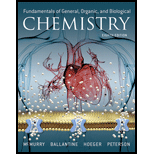
(a)
Interpretation:
How does a state of acidosis help to increase the generation of carbon dioxide has to be given.
Concept Introduction:
Acid Catalyzed Hydration Reaction: The reaction involves breaking of
(b)
Interpretation:
The effects of added reactants and products on equilibrium works on which principle has to be given.
Concept Introduction:
Another way of defining equilibrium is to say that a system is in equilibrium when the formation and reverse reaction occur at equal rates.
Want to see the full answer?
Check out a sample textbook solution
Chapter 22 Solutions
Fundamentals of General, Organic, and Biological Chemistry (8th Edition)
- Calculate the pH of a blood plasma sample with a total CO2 concentration of 26.9 mM and bicarbonate concentration of 25.6 mM. Recall from page 67 that the relevant pK2 of carbonic acid is 6.1arrow_forwardWhat mass of citric acid (triprotic, C6H5O7H3) contains 152 mEq of citric acid?arrow_forwardWrite a balanced equation for the neutralization of stomach acid by NahCO3 .arrow_forward
- Consider the reaction converting succinate into fumarate (see p. 560). (a) Is succinate oxidized or reduced in this reaction (and how do you know)? (b) You add molecular O2 as the redox partner for this reaction. Draw the Lewis dot structures for the relevant moeities on succinate, fumarate, O2 and H2O. (c) What is AG" for for the conversion of succinate into fumarate in the presence of O2 and H2O?arrow_forwardIn what range would the blood pH of a heavy smoker with advanced emphysema fall: (a) less than 7.35; (b) 7.35–7.45; (c) greater than 7.45? Explain your choice.arrow_forwardConcerning the reaction that is catalysed by carbonic anhydrase in red blood cells, briefly describe how the products of this reaction contribute to the buffering capacity of body fluids .arrow_forward
- Which of the equations below best represents how excess acid in the blood plasma can be removed in the lungs by breathing? H+ (aq) + 0. 2(g) OH + H₂ CO (aq) OH+ + O (aq) 2(g) → H, CO. H + O₂ (aq) 2(g) 3(aq) 3(aq) → H₂O(g) + CO2(g) + CO2(g) → H₂O H, CO3(aq) → HCO, OH t + HCO3(aq) → H₂ CO3(g) → H₂O(g) (aq) → H, CO3(aq) 3 (aq) + CO2(g) H₂O(g) + CO2(g)arrow_forwardConsumption of nitrate-rich vegetables such as spinach have been shown to reduce blood pressure in prehypertensive individuals (i.e., those having no history of clinical hypertension), a phenomenon attributed to increased nitric oxide synthesis. Describe the reactions that convert nitrate (NO3 −) to nitric oxide (NO•) in the body.arrow_forwardThe of the principal effects of diarrhea is the excretion (elimination through the bowels) of large quantities of sodium bicarbonate. Draw the equilibrium reaction showing the bicarbonate equilibrium. In which direction does the bicarbonate buffer system shift under these circumstances?arrow_forward
- During the treatment for COVID-19, one complication includes an increase of CO2 in the lungs. This buildup of CO2 can result in a serious condition called respiratory acidosis if the level of H+ significantly changes. If the pH drops by 1 unit, what has happened to the H+ concentration?arrow_forwardWrite a balanced equation for each of the following singlereplacement reactions. (a) Zinc granules are added to carbonic acid. (b) Cadmium metal is added to acetic acid.arrow_forwardA 48-year-old woman with a 3-day history of nausea and vomiting has deep sighing respiration and her breath smells sweet. The receiving physician's clinical diagnosis is diabetic ketoacidosis (DKA). Further investigations revealed: plasma glucose is very high (often>40 mmol/L), along with raised urea and creatinine. With the patient's condition, discuss the biochemistry why she became hypovolemic?arrow_forward
 BiochemistryBiochemistryISBN:9781319114671Author:Lubert Stryer, Jeremy M. Berg, John L. Tymoczko, Gregory J. Gatto Jr.Publisher:W. H. Freeman
BiochemistryBiochemistryISBN:9781319114671Author:Lubert Stryer, Jeremy M. Berg, John L. Tymoczko, Gregory J. Gatto Jr.Publisher:W. H. Freeman Lehninger Principles of BiochemistryBiochemistryISBN:9781464126116Author:David L. Nelson, Michael M. CoxPublisher:W. H. Freeman
Lehninger Principles of BiochemistryBiochemistryISBN:9781464126116Author:David L. Nelson, Michael M. CoxPublisher:W. H. Freeman Fundamentals of Biochemistry: Life at the Molecul...BiochemistryISBN:9781118918401Author:Donald Voet, Judith G. Voet, Charlotte W. PrattPublisher:WILEY
Fundamentals of Biochemistry: Life at the Molecul...BiochemistryISBN:9781118918401Author:Donald Voet, Judith G. Voet, Charlotte W. PrattPublisher:WILEY BiochemistryBiochemistryISBN:9781305961135Author:Mary K. Campbell, Shawn O. Farrell, Owen M. McDougalPublisher:Cengage Learning
BiochemistryBiochemistryISBN:9781305961135Author:Mary K. Campbell, Shawn O. Farrell, Owen M. McDougalPublisher:Cengage Learning BiochemistryBiochemistryISBN:9781305577206Author:Reginald H. Garrett, Charles M. GrishamPublisher:Cengage Learning
BiochemistryBiochemistryISBN:9781305577206Author:Reginald H. Garrett, Charles M. GrishamPublisher:Cengage Learning Fundamentals of General, Organic, and Biological ...BiochemistryISBN:9780134015187Author:John E. McMurry, David S. Ballantine, Carl A. Hoeger, Virginia E. PetersonPublisher:PEARSON
Fundamentals of General, Organic, and Biological ...BiochemistryISBN:9780134015187Author:John E. McMurry, David S. Ballantine, Carl A. Hoeger, Virginia E. PetersonPublisher:PEARSON





